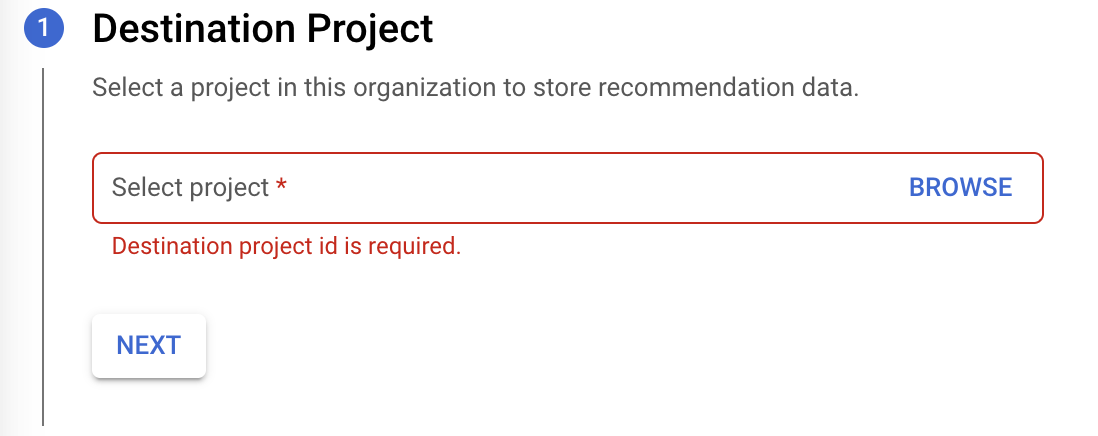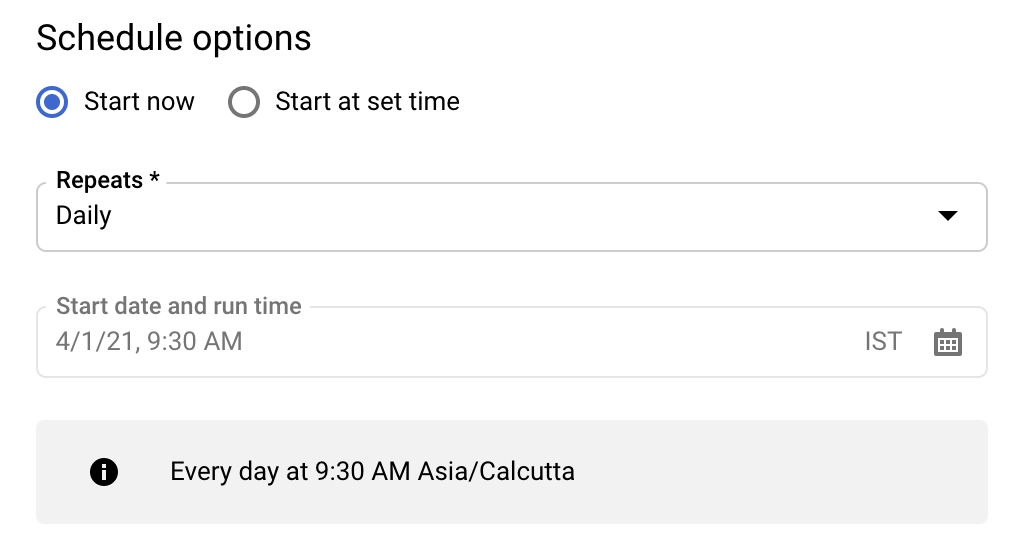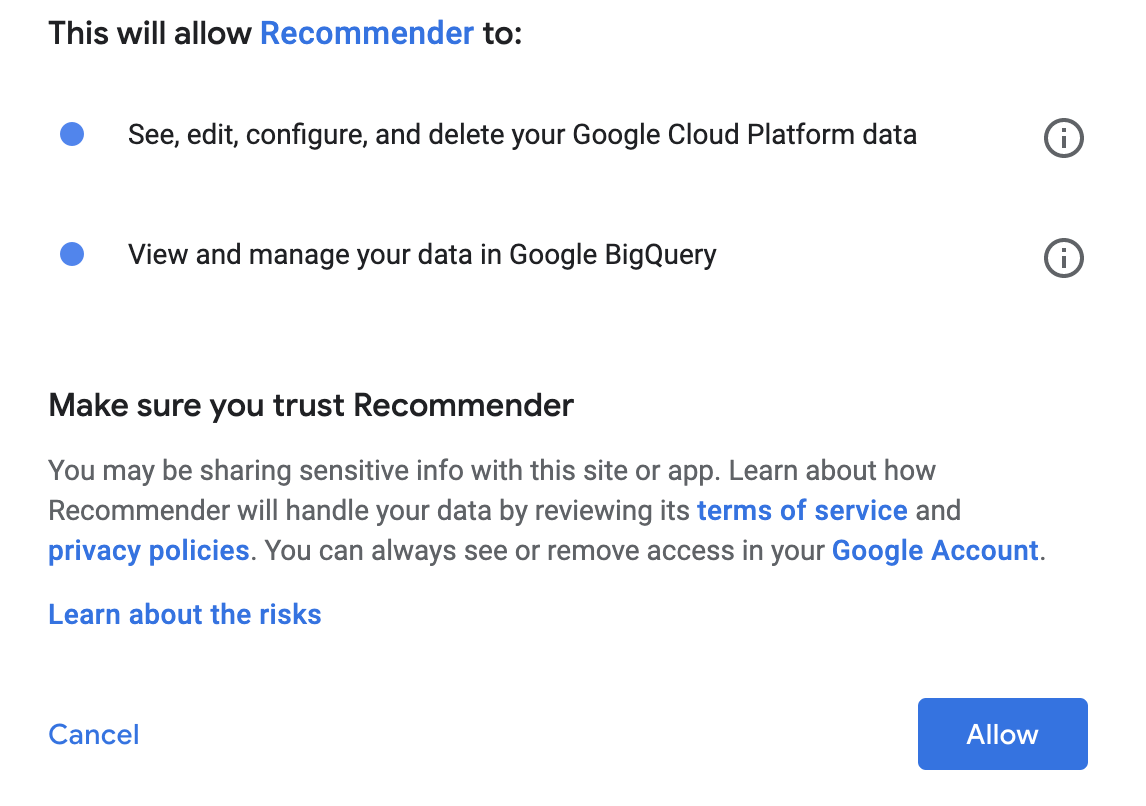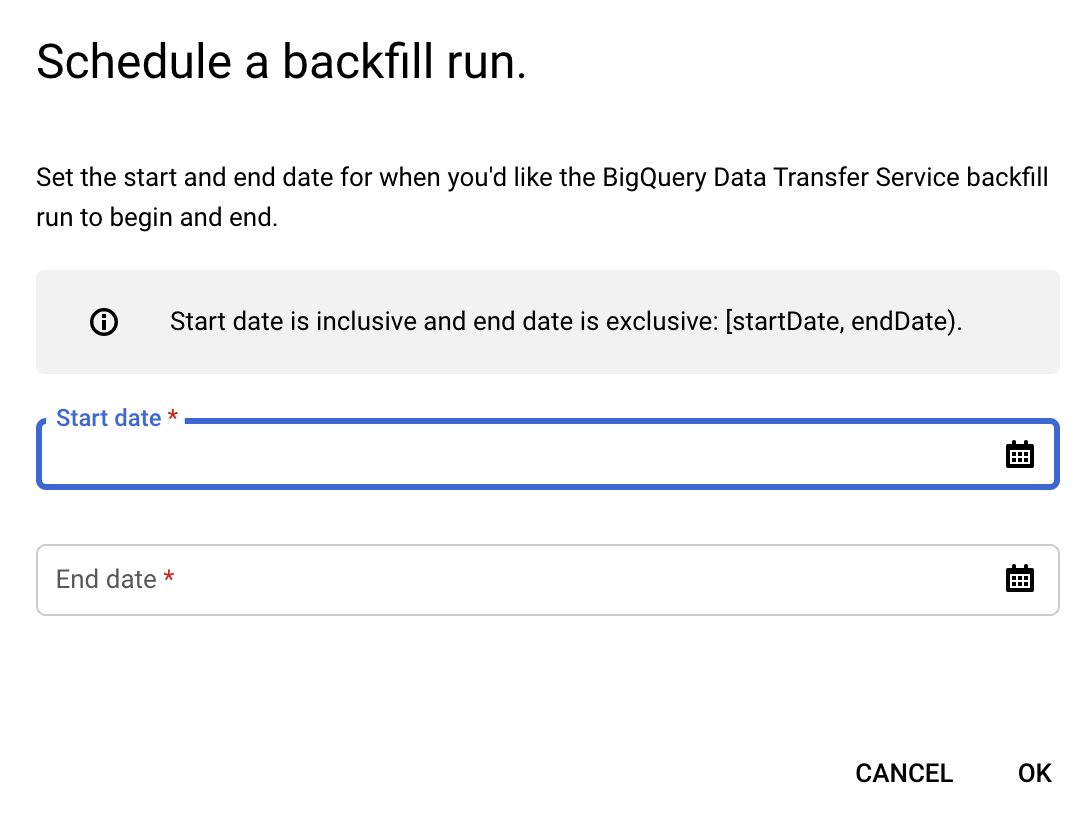將建議匯出至 BigQuery
總覽
透過 BigQuery 匯出功能,您可以查看機構每日的建議快照。這項作業是透過 BigQuery 資料移轉服務完成。請參閱這份文件,瞭解目前 BigQuery Export 支援哪些建議。
事前準備
建立建議資料移轉作業前,請完成下列步驟:
- 允許 BigQuery 資料移轉服務管理資料移轉作業。如果您使用 BigQuery 網頁版 UI 建立移轉作業,請在瀏覽器中允許來自
console.cloud.google.com的彈出式視窗,以便查看權限。詳情請參閱 啟用 BigQuery 資料移轉服務。 - 建立
BigQuery 資料集來儲存資料。
- 資料移轉作業會使用建立資料集的相同區域。 資料集和移轉作業建立後,位置就無法變更。
- 資料集會包含全球所有區域的洞察資料和建議。因此,這項作業會在處理期間將所有資料匯總到全球區域。如有任何資料落地問題,請參閱 Google Cloud Customer Care。
- 如果資料集位置是新推出的位置,初始匯出資料可能會有延遲。
定價
所有推薦功能客戶都可以將建議匯出至 BigQuery,但須視推薦功能定價層級而定。
所需權限
設定資料移轉作業時,您需要在建立資料移轉作業的專案層級具備下列權限:
bigquery.transfers.update- 允許您建立移轉作業bigquery.datasets.update- 允許您更新目標資料集的動作resourcemanager.projects.update- 讓你選取要儲存匯出資料的專案pubsub.topics.list:可選取 Pub/Sub 主題,以便接收匯出作業的相關通知
您必須具備下列組織層級權限。這個機構與您要設定匯出的機構相符。
recommender.resources.export- 允許您將建議匯出至 BigQuery
如要匯出成本節省建議的協商價格,必須具備下列權限:
billing.resourceCosts.get at project level- 允許匯出專案層級建議的議定價格billing.accounts.getSpendingInformation at billing account level- 允許匯出帳單帳戶層級建議的議定價格
如果沒有這些權限,系統會以標準價格而非議定價格匯出節省費用建議。
授予權限
您必須在建立資料移轉作業的專案中,授予下列角色:
- BigQuery 管理員角色 -
roles/bigquery.admin - 「專案擁有者」角色 -
roles/owner - 專案擁有者角色 -
roles/owner - 專案檢視者角色 -
roles/viewer - 專案編輯者角色 -
roles/editor - 「帳單帳戶管理員」角色 -
roles/billing.admin - 「帳單帳戶費用管理員」角色 -
roles/billing.costsManager - 帳單帳戶檢視者角色 -
roles/billing.viewer
如要允許您在目標資料集上建立移轉作業及更新動作,您必須授予下列角色:
有多個角色包含權限,可選取專案來儲存匯出資料,以及選取 Pub/Sub 主題來接收通知。如要同時擁有這兩項權限,可以授予下列角色:
有多個角色包含 billing.resourceCosts.get 權限,可匯出成本節省專案層級建議的議定價格,您可以授予其中任一角色:
有多個角色包含 billing.accounts.getSpendingInformation 權限,可匯出費用節省帳單帳戶層級建議的議定價格,您可以授予其中任一角色:
您必須在機構層級授予下列角色:
- 建議匯出者 (
roles/recommender.exporter) 角色。 Google Cloud
建立建議的資料移轉作業
登入 Google Cloud 主控台。
在「首頁」畫面中,按一下「建議」分頁標籤。
按一下「匯出」,查看 BigQuery 匯出表單。
選取要儲存建議資料的「目的地專案」,然後按一下「下一步」。


按一下「啟用 API」,啟用匯出作業所需的 BigQuery API。 這項作業需要幾秒鐘才能完成。完成後,按一下「繼續」。
在「設定轉移」表單中,提供下列詳細資料:
在「Transfer config name」(轉移設定名稱) 部分,針對「Display name」(顯示名稱) 輸入移轉作業的名稱。移轉作業名稱可以是任何容易辨識的值,方便您日後在必要時進行修改。


在「Schedule options」(排程選項) 區段中,針對「Schedule」(排程) 保留預設值 ([Start now] (立即開始)),或按一下「Start at a set time」(於設定的時間開始)。
針對「Repeats」(重複時間間隔),選擇您要多久執行移轉作業一次的選項。
- Daily (每天) (預設)
- Weekly (每週)
- Monthly (每月)
- Custom (自訂)
- 隨選
在「Start date and run time」(開始日期和執行時間) 部分,輸入開始移轉的日期與時間。如果您選擇 [Start now] (立即開始),系統就會停用這個選項。


在「Destination settings」(目的地設定) 部分,「Destination dataset」(目的地資料集) 請選取您為了儲存資料而建立的資料集 ID。


在「Data source details」(資料來源詳細資料) 區段:
organization_id 的預設值是您目前查看建議的機構。如要將建議匯出至其他機構,請在機構檢視器中變更控制台頂端的設定。


(選用) 在「Notification options」(通知選項) 區段中:
- 按一下啟用電子郵件通知的切換開關。啟用這個選項之後,若移轉失敗,移轉作業管理員就會收到電子郵件通知。
- 在「Select a Pub/Sub topic」(選取 Pub/Sub 主題) 選取主題名稱,或是點選「Create a topic」(建立主題)。這個選項會針對移轉作業設定 Pub/Sub 執行通知。


按一下「建立」,建立轉移作業。
在同意聲明彈出式視窗中,按一下「允許」。


建立轉移作業後,系統會將您重新導向回 Active Assist。 按一下連結即可存取移轉設定詳細資料。或者,您也可以按照下列步驟存取轉移內容:
前往 Google Cloud 控制台的「BigQuery」頁面。
按一下「資料移轉」。您可以查看所有可用的資料移轉。
查看移轉作業的執行記錄
如要查看移轉作業的執行記錄,請按照下列步驟操作:
前往 Google Cloud 控制台的「BigQuery」頁面。
按一下「資料移轉」。您可以查看所有可用的資料移轉。
在清單中按一下適當的移轉項目。
在「執行記錄」分頁下方顯示的執行移轉作業清單中,選取要查看詳細資料的移轉作業。
系統會顯示所選個別跑步活動的「跑步詳細資料」面板。 系統可能會顯示下列執行詳細資料:
- 由於來源資料無法使用,因此移轉作業已延後。
- 工作:指出匯出至表格的列數
- 缺少資料來源的權限,您必須授予權限,然後排定回填時間。
資料匯出時間
建立資料移轉作業後,系統會在兩天內首次匯出資料。 第一次匯出作業完成後,匯出工作會按照您在設定時要求的頻率執行。申請條件如下:
特定日期 (D) 的匯出工作會將當天結束 (D) 的資料匯出至 BigQuery 資料集,通常會在隔天結束 (D+1) 前完成。匯出作業會在太平洋標準時間時區執行,因此其他時區可能會出現額外延遲。
系統會等到所有要匯出的資料都備妥後,才會執行每日匯出工作。這可能會導致資料集更新的日期和時間有所差異,有時甚至會延遲。因此,最好使用最新的可用資料快照,而不是對特定日期資料表有時間敏感的硬性依附元件。
匯出作業會轉移各區域的最新可用資料,因此不同區域的建議可能會有不同的最新日期。
匯出作業的常見狀態訊息
瞭解將建議匯出至 BigQuery 時,常見的狀態訊息。
使用者沒有必要權限
如果使用者沒有必要權限,就會看到以下訊息:recommender.resources.export。你會看到以下訊息:
User does not have required permission "recommender.resources.export". Please, obtain the required permissions for the datasource and try again by triggering a backfill for this date
如要解決這個問題,請將 IAM 角色 roles/recommender.exporter 授予user/service account,在機構層級為設定匯出的機構設定匯出作業。可透過下列 gcloud 指令授予:
使用者:
gcloud organizations add-iam-policy-binding *<organization_id>* --member='user:*<user_name>*' --role='roles/recommender.exporter'如果是服務帳戶:
gcloud organizations add-iam-policy-binding *<organization_id>* --member='serviceAccount:*<service_acct_name>*' --role='roles/recommender.exporter'
由於來源資料無法使用,因此轉移作業已延後
如果來源資料尚未提供,系統會重新安排移轉作業,並顯示以下訊息。這並非錯誤。這表示當天的匯出管道尚未完成。轉移作業會在新的排定時間重新執行,並在匯出管道完成後成功執行。你會看到以下訊息:
Transfer deferred due to source data not being available
找不到來源資料
如果 F1toPlacer 管道已完成,但系統未找到為匯出作業設定的機構提供任何建議或洞察資料,就會顯示以下訊息。你會看到以下訊息:
Source data not found for 'recommendations_export$<date>'insights_export$<date>
看到這則訊息的原因如下:
- 使用者在 2 天前設定匯出功能。客戶指南會告知顧客,匯出作業完成後,資料會延遲一天才會提供。
- 特定日期沒有該機構的建議或洞察資料。這可能是實際情況,也可能是因為管道在當天所有建議或洞察資料都可用之前就已執行。
查看轉移作業的資料表
將建議匯出至 BigQuery 時,資料集會包含兩個按日期分區的資料表:
- recommendations_export
- insight_export
如要進一步瞭解資料表和結構定義,請參閱「建立及使用資料表」和「指定結構定義」。
如要查看資料移轉的資料表,請按照下列步驟操作:
前往 Google Cloud 控制台的「BigQuery」頁面。 前往 BigQuery 頁面
按一下「資料移轉」。您可以查看所有可用的資料移轉。
在清單中按一下適當的移轉項目。
按一下「設定」分頁標籤,然後點選資料集。
在「Explorer」面板中展開專案並選取資料集。 說明和詳細資料會顯示在詳細資料面板中。在「Explorer」面板中,資料集名稱下方會列出資料表。
排程補充作業
如要匯出過去某個日期的建議 (這個日期晚於機構啟用匯出功能的日期),請排定回填作業。如要排定補充作業時間,請按照下列步驟操作:
前往 Google Cloud 控制台的「BigQuery」頁面。
按一下「資料移轉」。
在「Transfers」(傳輸作業) 頁面中,於清單中按一下適當的移轉項目。
按一下「排定回填時間」。
在「Schedule backfill」(安排補充作業) 對話方塊中,選擇「Start date」(開始日期) 和「End date」(結束日期)。


如要進一步瞭解如何使用移轉作業,請參閱「使用移轉作業」一文。
匯出架構
最佳化建議匯出表格:
schema:
fields:
- name: cloud_entity_type
type: STRING
description: |
Represents what cloud entity type the recommendation was generated for - eg: project number, billing account
- name: cloud_entity_id
type: STRING
description: |
Value of the project number or billing account id
- name: name
type: STRING
description: |
Name of recommendation. A project recommendation is represented as
projects/[PROJECT_NUMBER]/locations/[LOCATION]/recommenders/[RECOMMENDER_ID]/recommendations/[RECOMMENDATION_ID]
- name: location
type: STRING
description: |
Location for which this recommendation is generated
- name: recommender
type: STRING
description: |
Recommender ID of the recommender that has produced this recommendation
- name: recommender_subtype
type: STRING
description: |
Contains an identifier for a subtype of recommendations produced for the
same recommender. Subtype is a function of content and impact, meaning a
new subtype will be added when either content or primary impact category
changes.
Examples:
For recommender = "google.iam.policy.Recommender",
recommender_subtype can be one of "REMOVE_ROLE"/"REPLACE_ROLE"
- name: target_resources
type: STRING
mode: REPEATED
description: |
Contains the fully qualified resource names for resources changed by the
operations in this recommendation. This field is always populated. ex:
[//cloudresourcemanager.googleapis.com/projects/foo].
- name: description
type: STRING
description: |
Required. Free-form human readable summary in English.
The maximum length is 500 characters.
- name: last_refresh_time
type: TIMESTAMP
description: |
Output only. Last time this recommendation was refreshed by the system that created it in the first place.
- name: primary_impact
type: RECORD
description: |
Required. The primary impact that this recommendation can have while trying to optimize
for one category.
schema:
fields:
- name: category
type: STRING
description: |
Category that is being targeted.
Values can be the following:
CATEGORY_UNSPECIFIED:
Default unspecified category. Do not use directly.
COST:
Indicates a potential increase or decrease in cost.
SECURITY:
Indicates a potential increase or decrease in security.
PERFORMANCE:
Indicates a potential increase or decrease in performance.
RELIABILITY:
Indicates a potential increase or decrease in reliability.
- name: cost_projection
type: RECORD
description: Optional. Use with CategoryType.COST
schema:
fields:
- name: cost
type: RECORD
description: |
An approximate projection on amount saved or amount incurred.
Negative cost units indicate cost savings and positive cost units indicate
increase. See google.type.Money documentation for positive/negative units.
schema:
fields:
- name: currency_code
type: STRING
description: The 3-letter currency code defined in ISO 4217.
- name: units
type: INTEGER
description: |
The whole units of the amount. For example if `currencyCode` is `"USD"`,
then 1 unit is one US dollar.
- name: nanos
type: INTEGER
description: |
Number of nano (10^-9) units of the amount.
The value must be between -999,999,999 and +999,999,999 inclusive.
If `units` is positive, `nanos` must be positive or zero.
If `units` is zero, `nanos` can be positive, zero, or negative.
If `units` is negative, `nanos` must be negative or zero.
For example $-1.75 is represented as `units`=-1 and `nanos`=-750,000,000.
- name: cost_in_local_currency
type: RECORD
description: |
An approximate projection on amount saved or amount incurred in the local currency.
Negative cost units indicate cost savings and positive cost units indicate
increase. See google.type.Money documentation for positive/negative units.
schema:
fields:
- name: currency_code
type: STRING
description: The 3-letter currency code defined in ISO 4217.
- name: units
type: INTEGER
description: |
The whole units of the amount. For example if `currencyCode` is `"USD"`,
then 1 unit is one US dollar.
- name: nanos
type: INTEGER
description: |
Number of nano (10^-9) units of the amount.
The value must be between -999,999,999 and +999,999,999 inclusive.
If `units` is positive, `nanos` must be positive or zero.
If `units` is zero, `nanos` can be positive, zero, or negative.
If `units` is negative, `nanos` must be negative or zero.
For example $-1.75 is represented as `units`=-1 and `nanos`=-750,000,000.
- name: duration
type: RECORD
description: Duration for which this cost applies.
schema:
fields:
- name: seconds
type: INTEGER
description: |
Signed seconds of the span of time. Must be from -315,576,000,000
to +315,576,000,000 inclusive. Note: these bounds are computed from:
60 sec/min * 60 min/hr * 24 hr/day * 365.25 days/year * 10000 years
- name: nanos
type: INTEGER
description: |
Signed fractions of a second at nanosecond resolution of the span
of time. Durations less than one second are represented with a 0
`seconds` field and a positive or negative `nanos` field. For durations
of one second or more, a non-zero value for the `nanos` field must be
of the same sign as the `seconds` field. Must be from -999,999,999
to +999,999,999 inclusive.
- name: pricing_type_name
type: STRING
description: |
A pricing type can either be based on the price listed on GCP (LIST) or a custom
price based on past usage (CUSTOM).
- name: reliability_projection
type: RECORD
description: Optional. Use with CategoryType.RELIABILITY
schema:
fields:
- name: risk_types
type: STRING
mode: REPEATED
description: |
The risk associated with the reliability issue.
RISK_TYPE_UNSPECIFIED:
Default unspecified risk. Do not use directly.
SERVICE_DISRUPTION:
Potential service downtime.
DATA_LOSS:
Potential data loss.
ACCESS_DENY:
Potential access denial. The service is still up but some or all clients
can not access it.
- name: details_json
type: STRING
description: |
Additional reliability impact details that is provided by the recommender in JSON
format.
- name: state
type: STRING
description: |
Output only. The state of the recommendation:
STATE_UNSPECIFIED:
Default state. Do not use directly.
ACTIVE:
Recommendation is active and can be applied. Recommendations content can
be updated by Google.
ACTIVE recommendations can be marked as CLAIMED, SUCCEEDED, or FAILED.
CLAIMED:
Recommendation is in claimed state. Recommendations content is
immutable and cannot be updated by Google.
CLAIMED recommendations can be marked as CLAIMED, SUCCEEDED, or FAILED.
SUCCEEDED:
Recommendation is in succeeded state. Recommendations content is
immutable and cannot be updated by Google.
SUCCEEDED recommendations can be marked as SUCCEEDED, or FAILED.
FAILED:
Recommendation is in failed state. Recommendations content is immutable
and cannot be updated by Google.
FAILED recommendations can be marked as SUCCEEDED, or FAILED.
DISMISSED:
Recommendation is in dismissed state.
DISMISSED recommendations can be marked as ACTIVE.
- name: ancestors
type: RECORD
description: |
Ancestry for the recommendation entity
schema:
fields:
- name: organization_id
type: STRING
description: |
Organization to which the recommendation project
- name: folder_ids
type: STRING
mode: REPEATED
description: |
Up to 5 levels of parent folders for the recommendation project
- name: associated_insights
type: STRING
mode: REPEATED
description: |
Insights associated with this recommendation. A project insight is represented as
projects/[PROJECT_NUMBER]/locations/[LOCATION]/insightTypes/[INSIGHT_TYPE_ID]/insights/[insight_id]
- name: recommendation_details
type: STRING
description: |
Additional details about the recommendation in JSON format.
schema:
- name: overview
type: RECORD
description: Overview of the recommendation in JSON format
- name: operation_groups
type: OperationGroup
mode: REPEATED
description: Operations to one or more Google Cloud resources grouped in such a way
that, all operations within one group are expected to be performed
atomically and in an order. More here: https://cloud.google.com/recommender/docs/key-concepts#operation_groups
- name: operations
type: Operation
description: An Operation is the individual action that must be performed as one of the atomic steps in a suggested recommendation. More here: https://cloud.google.com/recommender/docs/key-concepts?#operation
- name: state_metadata
type: map with key: STRING, value: STRING
description: A map of STRING key, STRING value of metadata for the state, provided by user or automations systems.
- name: additional_impact
type: Impact
mode: REPEATED
description: Optional set of additional impact that this recommendation may have when
trying to optimize for the primary category. These may be positive
or negative. More here: https://cloud.google.com/recommender/docs/key-concepts?#recommender_impact
- name: priority
type: STRING
description: |
Priority of the recommendation:
PRIORITY_UNSPECIFIED:
Default unspecified priority. Do not use directly.
P4:
Lowest priority.
P3:
Second lowest priority.
P2:
Second highest priority.
P1:
Highest priority.
洞察資料匯出表格:
schema:
- fields:
- name: cloud_entity_type
type: STRING
description: |
Represents what cloud entity type the recommendation was generated for - eg: project number, billing account
- name: cloud_entity_id
type: STRING
description: |
Value of the project number or billing account id
- name: name
type: STRING
description: |
Name of recommendation. A project recommendation is represented as
projects/[PROJECT_NUMBER]/locations/[LOCATION]/recommenders/[RECOMMENDER_ID]/recommendations/[RECOMMENDATION_ID]
- name: location
type: STRING
description: |
Location for which this recommendation is generated
- name: insight_type
type: STRING
description: |
Recommender ID of the recommender that has produced this recommendation
- name: insight_subtype
type: STRING
description: |
Contains an identifier for a subtype of recommendations produced for the
same recommender. Subtype is a function of content and impact, meaning a
new subtype will be added when either content or primary impact category
changes.
Examples:
For recommender = "google.iam.policy.Recommender",
recommender_subtype can be one of "REMOVE_ROLE"/"REPLACE_ROLE"
- name: target_resources
type: STRING
mode: REPEATED
description: |
Contains the fully qualified resource names for resources changed by the
operations in this recommendation. This field is always populated. ex:
[//cloudresourcemanager.googleapis.com/projects/foo].
- name: description
type: STRING
description: |
Required. Free-form human readable summary in English.
The maximum length is 500 characters.
- name: last_refresh_time
type: TIMESTAMP
description: |
Output only. Last time this recommendation was refreshed by the system that created it in the first place.
- name: category
type: STRING
description: |
Category being targeted by the insight. Can be one of:
Unspecified category.
CATEGORY_UNSPECIFIED = Unspecified category.
COST = The insight is related to cost.
SECURITY = The insight is related to security.
PERFORMANCE = The insight is related to performance.
MANAGEABILITY = The insight is related to manageability.
RELIABILITY = The insight is related to reliability.;
- name: state
type: STRING
description: |
Output only. The state of the recommendation:
STATE_UNSPECIFIED:
Default state. Do not use directly.
ACTIVE:
Recommendation is active and can be applied. Recommendations content can
be updated by Google.
ACTIVE recommendations can be marked as CLAIMED, SUCCEEDED, or FAILED.
CLAIMED:
Recommendation is in claimed state. Recommendations content is
immutable and cannot be updated by Google.
CLAIMED recommendations can be marked as CLAIMED, SUCCEEDED, or FAILED.
SUCCEEDED:
Recommendation is in succeeded state. Recommendations content is
immutable and cannot be updated by Google.
SUCCEEDED recommendations can be marked as SUCCEEDED, or FAILED.
FAILED:
Recommendation is in failed state. Recommendations content is immutable
and cannot be updated by Google.
FAILED recommendations can be marked as SUCCEEDED, or FAILED.
DISMISSED:
Recommendation is in dismissed state.
DISMISSED recommendations can be marked as ACTIVE.
- name: ancestors
type: RECORD
description: |
Ancestry for the recommendation entity
schema:
fields:
- name: organization_id
type: STRING
description: |
Organization to which the recommendation project
- name: folder_ids
type: STRING
mode: REPEATED
description: |
Up to 5 levels of parent folders for the recommendation project
- name: associated_recommendations
type: STRING
mode: REPEATED
description: |
Insights associated with this recommendation. A project insight is represented as
projects/[PROJECT_NUMBER]/locations/[LOCATION]/insightTypes/[INSIGHT_TYPE_ID]/insights/[insight_id]
- name: insight_details
type: STRING
description: |
Additional details about the insight in JSON format
schema:
fields:
- name: content
type: STRING
description: |
A struct of custom fields to explain the insight.
Example: "grantedPermissionsCount": "1000"
- name: observation_period
type: TIMESTAMP
description: |
Observation period that led to the insight. The source data used to
generate the insight ends at last_refresh_time and begins at
(last_refresh_time - observation_period).
- name: state_metadata
type: STRING
description: |
A map of metadata for the state, provided by user or automations systems.
- name: severity
type: STRING
description: |
Severity of the insight:
SEVERITY_UNSPECIFIED:
Default unspecified severity. Do not use directly.
LOW:
Lowest severity.
MEDIUM:
Second lowest severity.
HIGH:
Second highest severity.
CRITICAL:
Highest severity.
查詢範例
您可以使用下列查詢範例分析匯出的資料。
查看建議的費用節省金額 (建議時間以天為單位)
SELECT name, recommender, target_resources,
case primary_impact.cost_projection.cost.units is null
when true then round(primary_impact.cost_projection.cost.nanos * power(10,-9),2)
else
round( primary_impact.cost_projection.cost.units +
(primary_impact.cost_projection.cost.nanos * power(10,-9)), 2)
end
as dollar_amt,
primary_impact.cost_projection.duration.seconds/(60*60*24) as duration_in_days
FROM `<project>.<dataset>.recommendations_export`
WHERE DATE(_PARTITIONTIME) = "<date>"
and primary_impact.category = "COST"
查看未使用的 IAM 角色清單
SELECT *
FROM `<project>.<dataset>.recommendations_export`
WHERE DATE(_PARTITIONTIME) = "<date>"
and recommender = "google.iam.policy.Recommender"
and recommender_subtype = "REMOVE_ROLE"
查看必須替換為較小角色的已授予角色清單
SELECT *
FROM `<project>.<dataset>.recommendations_export`
WHERE DATE(_PARTITIONTIME) = "<date>"
and recommender = "google.iam.policy.Recommender"
and recommender_subtype = "REPLACE_ROLE"
查看最佳化建議的洞察資料
SELECT recommendations.name as recommendation_name,
insights.name as insight_name,
recommendations.cloud_entity_id,
recommendations.cloud_entity_type,
recommendations.recommender,
recommendations.recommender_subtype,
recommendations.description,
recommendations.target_resources,
recommendations.recommendation_details,
recommendations.state,
recommendations.last_refresh_time as recommendation_last_refresh_time,
insights.insight_type,
insights.insight_subtype,
insights.category,
insights.description,
insights.insight_details,
insights.state,
insights.last_refresh_time as insight_last_refresh_time
FROM `<project>.<dataset>.recommendations_export` as recommendations,
`<project>.<dataset>.insights_export` as insights
WHERE DATE(recommendations._PARTITIONTIME) = "<date>"
and DATE(insights._PARTITIONTIME) = "<date>"
and insights.name in unnest(recommendations.associated_insights)
查看特定資料夾中專案的建議
這項查詢會傳回專案最多五個層級的上層資料夾。
SELECT *
FROM `<project>.<dataset>.recommendations_export`
WHERE DATE(_PARTITIONTIME) = "<date>"
and "<folder_id>" in unnest(ancestors.folder_ids)
查看目前匯出最新日期的建議
DECLARE max_date TIMESTAMP;
SET max_date = (
SELECT MAX(_PARTITIONTIME) FROM
`<project>.<dataset>.recommendations_export`
);
SELECT *
FROM `<project>.<dataset>.recommendations_export`
WHERE _PARTITIONTIME = max_date
使用試算表探索 BigQuery 資料
除了在 BigQuery 上執行查詢,您也可以使用「連結試算表」功能,也就是新的 BigQuery 資料連接器,藉此存取、分析、共用並以圖表呈現試算表中數十億列的 BigQuery 資料。詳情請參閱「開始在 Google 試算表中使用 BigQuery 資料」。
使用 BigQuery 指令列和 REST API 設定匯出作業
-
您可以透過 Google Cloud 主控台或指令列取得必要的 Identity and Access Management 權限。
舉例來說,如要使用指令列取得服務帳戶的機構層級 recommender.resources.export 權限,請執行下列指令:
gcloud organizations add-iam-policy-binding *<organization_id>* --member=serviceAccount:*<service_acct_name>*' --role='roles/recommender.exporter' -
Datasource to use: 6063d10f-0000-2c12-a706-f403045e6250 建立匯出作業:
使用 BigQuery 指令列:
bq mk \ --transfer_config \ --project_id=project_id \ --target_dataset=dataset_id \ --display_name=name \ --params='parameters' \ --data_source=data_source \ --service_account_name=service_account_name
其中:
- project_id 是您的專案 ID。
- dataset 是移轉設定的目標資料集 ID。
- name 是移轉設定的顯示名稱。移轉作業名稱可以是任何容易辨識的值,方便您日後在必要時進行修改。
- parameters 含有已建立移轉設定的 JSON 格式參數,如要匯出建議和洞察資料至 BigQuery,您必須提供要匯出建議和洞察資料的 organization_id。參數格式:「{"organization_id":"<org id>"}'」
- data_source 要使用的資料來源:'6063d10f-0000-2c12-a706-f403045e6250'
- service_account_name 是用於驗證匯出的服務帳戶名稱。服務帳戶應由用於建立轉移作業的
project_id擁有,且應具備上述所有必要權限。
透過使用者介面或 BigQuery 指令列管理現有匯出作業:
注意:匯出作業會以設定帳戶的使用者身分執行,與日後更新匯出設定的使用者無關。舉例來說,如果匯出作業是透過服務帳戶設定,之後使用者透過 BigQuery 資料移轉服務 UI 更新匯出設定,匯出作業仍會以服務帳戶身分執行。在這種情況下,系統每次執行匯出作業時,都會檢查服務帳戶的「recommender.resources.export」權限。

